
The House of Bourbon is a dynasty that originated in the Kingdom of France as a branch of the Capetian dynasty, the royal House of France. Bourbon kings first ruled France and Navarre in the 16th century. A branch descended from the French Bourbons came to rule Spain in the 18th century and is the current Spanish royal family. Further branches, descended from the Spanish Bourbons, held thrones in Naples, Sicily, and Parma. Today, Spain and Luxembourg have monarchs of the House of Bourbon. The royal Bourbons originated in 1272, when Robert, the youngest son of King Louis IX of France, married the heiress of the lordship of Bourbon. The house continued for three centuries as a cadet branch, serving as nobles under the direct Capetian and Valois kings.
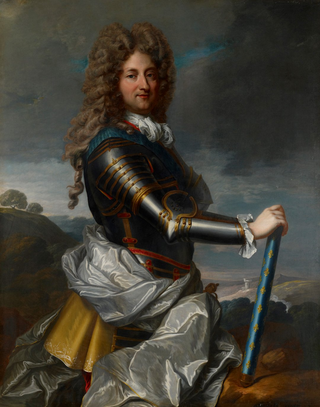
Philippe II, Duke of Orléans, was a French prince, soldier, and statesman who served as Regent of the Kingdom of France from 1715 to 1723. He is referred to in French as le Régent. He was the son of Monsieur Philippe I, Duke of Orleans, and Madame Elisabeth Charlotte, Duchess of Orléans. Born at his father's palace at Saint-Cloud, he was known from birth by the title of Duke of Chartres.

Louis François de Boufflers, Duke of Boufflers was a prominent French soldier in the age of Louis XIV of France. He was created count of Cagny and duke of Boufflers and named marshal of France. He was famed for his excellent defensive leadership during the sieges of Namur and Lille, next to his conduct during the Battle of Malplaquet.
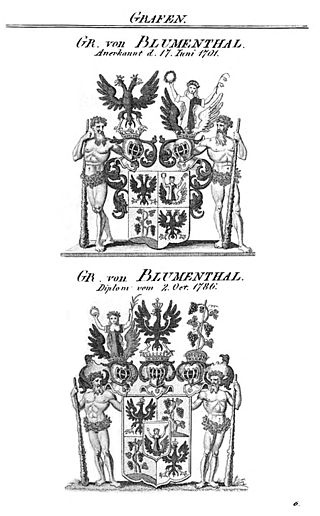
The Blumenthal family is a Lutheran and Roman Catholic German noble family, originally from Brandenburg-Prussia. Other (unrelated) families of this name exist in Switzerland and formerly in Russia, and many unrelated families called Blumenthal, without "von", are to be found worldwide.

The Castle of Freÿr with its gardens in the style of Le Nôtre is located in Wallonia on the left bank of the Meuse, between Waulsort and Dinant. They form one of the most magnificent natural sites in Belgium. It has been classified as one of Wallonia's major heritage sites. It is often called a greatly reduced Versailles. Originally a Renaissance castle, it was extended in the 18th century and was once the residence of dukes and their royal guests. It has gardens including orange trees. The more than three-hundred-year-old orangeries are the oldest in the Low Countries.

Antoine I de Croÿ, Seigneur de Croÿ, Renty and Le Roeulx, Count of Porcéan, was a member of the House of Croÿ.
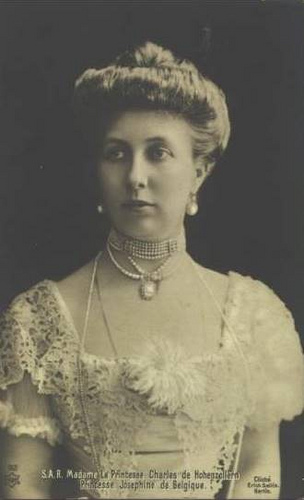
Princess Joséphine Caroline of Belgium was the youngest daughter of Prince Philippe, Count of Flanders and Princess Marie of Hohenzollern-Sigmaringen. She was an older sister of Albert I of Belgium.
When the Viking chieftain Rollo obtained the territories via the Treaty of Saint-Clair-sur-Epte which would later make up Normandy, he distributed them as estates among his main supporters. Among these lands were the seigneurie of Harcourt, near Brionne, and the county of Pont-Audemer, both of which Rollo granted to Bernard the Dane, ancestor of the lords (seigneurs) of Harcourt. he first to use Harcourt as a name, however, was Anquetil d'Harcourt at the start of the 11th century.

Philippe Jules Mancini, 8th Duke of Nevers (1641–1707) was the nephew of Cardinal Mazarin, chief minister of France immediately after the death of King Louis XIII. He was the brother of the five famous Mancini sisters, who, along with two of their female Martinozzi cousins, were known at the court of King Louis XIV of France as the Mazarinettes.

Princely Count Charles of Arenberg, duke of Aarschot, baron of Zevenbergen, knight of the Order of the Golden Fleece, was the second Princely Count of Arenberg and a leading aristocrat of the Habsburg Netherlands, who served as a courtier, soldier, minister and diplomat.

The title of Duke de La Rochefoucauld is a French peerage, from the great House La Rochefoucauld, cadets of the Lusignan family, whose origins go back to Lord Rochefoucauld in Charente in the 10th century with Foucauld 1st (973–1047), first Lord of La Roche then La Rochefoucauld, possibly son of Adémar, Lord of La Roche (952–1037). They got the title of Baron in the 13th century, then became Count in 1528 with François I de La Rochefoucauld, godfather of King François I and in 1622, François V de La Rochefoucauld, whose son François VI was a leading figure of La Fronde and the author of the Maxims, was made Duke by Louis XIII. They are also, since 16th century, Prince of Marcillac. Then they become during the 18th century: Duke of Liancourt, Duke of Anville and Duke of Estissac. Afterwards : Prince de La Rochefoucauld-Montbel, Duke of Doudeauville, Duke of Estrées and Duke of Bisaccia. They are also: Marquises of Montendre, of Barbezieux, of Surgères and Bayers; also Count de Duretal, Count de La Rochefoucauld-Montbel and Baron de Verteuil. They were : Blessed of the Catholic Church, cardinals, bishops, grand maîtres de la garde robe and Leader of the Kings hunts, chambellans, ministers, lieutenants general of the armies, UK field marshal, Denmark marshal, ambassadors, grand hospitaller of the Order of Malta, presidents and founders of multiple clubs. Many of them were elevated in the Order of the Légion d’Honneur and around 40 of them were/are members of the Sovereign Order of Malta. The castle of La Rochefoucauld is still in the famille since the 10th century. Also to be noted : The La Rochefoucauld-Montbel owned the Lascaux caves at the moment of their discovery and are closely linked to the Pellevoisin sanctuary in France.

The House of Ursel is the name of an old Belgian noble family of German origin. The Head of the House is styled as Duke of Ursel, while other members are styled as Count/Countess of Ursel.

The Castle of Beauvais is a French château located in the municipality of Lussas-et-Nontronneau, department of Dordogne, region of Nouvelle-Aquitaine, France. The castle was listed as a historic monument on 19 December 1973.
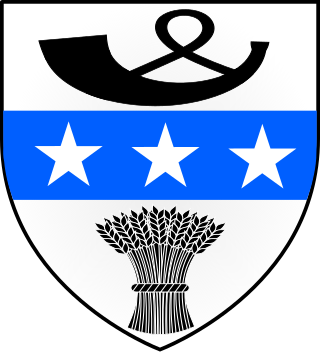
The Tabouillot family is a French noble family, originally from Regret, a village near Verdun. Family members were prominent in the legal profession, the church, as local government officials and as estate owners in Marville, Damvillers, Verdun and Metz, and the family was ennobled in the 18th century, becoming part of the French Nobles of the Robe.

The House of Lannoy is the name of an old and important Belgian noble family that takes its name from the town of Lannoy in northern France. The name comes from l'Annoy, which means 'the alderwood' in Picard French of Flanders.
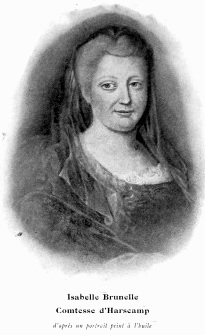
Isabelle Brunelle (1724–1805), countess d'Harscamp, was a refugee and philanthropist.
Baron Wilhelm Hugo von Spitzemberg was a German soldier who became a favourite of King Charles I of Württemberg.














